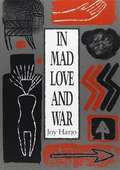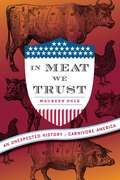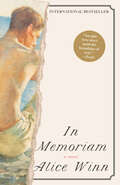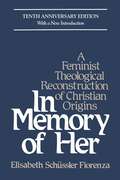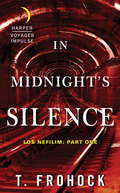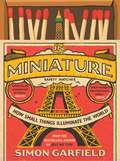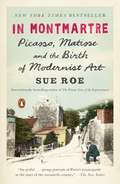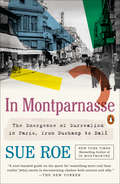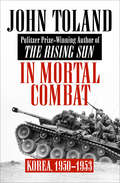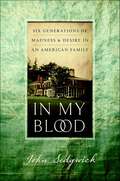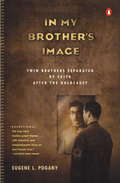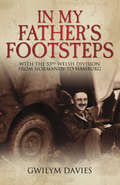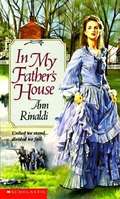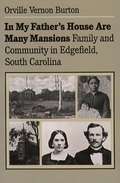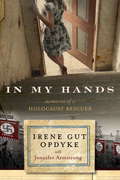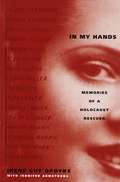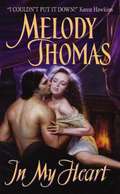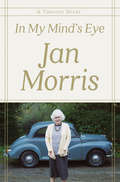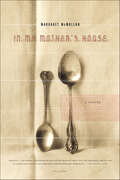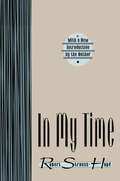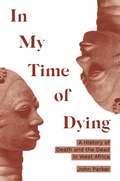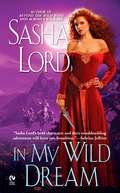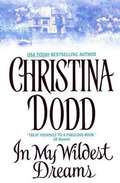- Table View
- List View
In Meat We Trust: An Unexpected History of Carnivore America
by Maureen OgleThe untold story of how meat made America: a tale of the self-made magnates, pragmatic farmers, and impassioned activists who shaped us into the greatest eaters and providers of meat in history "Ogle is a terrific writer, and she takes us on a brisk romp through two centuries of history, full of deft portraits of entrepreneurs, inventors, promoters and charlatans.... Ms. Ogle believes, all exceptions admitted, that [the food industry] has delivered Americans good value, and her book makes that case in fascinating detail." --Wall Street JournalThe moment European settlers arrived in North America, they began transforming the land into a meat-eater's paradise. Long before revolution turned colonies into nation, Americans were eating meat on a scale the Old World could neither imagine nor provide: an average European was lucky to see meat once a week, while even a poor American man put away about two hundred pounds a year.Maureen Ogle guides us from that colonial paradise to the urban meat-making factories of the nineteenth century to the hyperefficient packing plants of the late twentieth century. From Swift and Armour to Tyson, Cargill, and ConAgra. From the 1880s cattle bonanza to 1980s feedlots. From agribusiness to today's "local" meat suppliers and organic countercuisine. Along the way, Ogle explains how Americans' carnivorous demands shaped urban landscapes, midwestern prairies, and western ranges, and how the American system of meat making became a source of both pride and controversy.
In Memoriam: A novel
by Alice WinnGMA BUZZ PICK • INTERNATIONAL BEST SELLER AND AWARD WINNER • A haunting, virtuosic debut novel about two young men who fall in love during World War I • &“Will live in your mind long after you&’ve closed the final pages.&” —Maggie O&’Farrell, best-selling author of Hamnet and The Marriage PortraitA Best Book of the Year: The New Yorker, The Washington Post, NPR &“In Memoriam is the story of a great tragedy, but it is also a moving portrait of young love, and there is often a lightness to the book.&”—The New York TimesIt&’s 1914, and World War I is ceaselessly churning through thousands of young men on both sides of the fight. The violence of the front feels far away to Henry Gaunt, Sidney Ellwood and the rest of their classmates, safely ensconced in their idyllic boarding school in the English countryside. News of the heroic deaths of their friends only makes the war more exciting.Gaunt, half German, is busy fighting his own private battle--an all-consuming infatuation with his best friend, the glamorous, charming Ellwood--without a clue that Ellwood is pining for him in return. When Gaunt's family asks him to enlist to forestall the anti-German sentiment they face, Gaunt does so immediately, relieved to escape his overwhelming feelings for Ellwood. To Gaunt's horror, Ellwood rushes to join him at the front, and the rest of their classmates soon follow. Now death surrounds them in all its grim reality, often inches away, and no one knows who will be next.An epic tale of both the devastating tragedies of war and the forbidden romance that blooms in its grip, In Memoriam is a breathtaking debut.
In Memory of Her: A Feminist Theological Reconstruction of Christian Origins
by Elisabeth FiorenzaThis brilliant scholarly treatise succeeds in bringing to our consciousness women who played an important role in the origins of Christianity.
In Midnight's Silence
by T. FrohockThe fate of mankind has nothing to do with mankind...Born of an angel and a daimon, Diago Alvarez is a singular being in a country torn by a looming civil war and the spiritual struggle between the forces of angels and daimons. With allegiance to no one but his partner Miquel, he is content to simply live in Barcelona, caring only for the man he loves and the music he makes. Yet, neither side is satisfied to let him lead this domesticated life and, knowing they can't get to him directly, they do the one thing he's always feared.They go after Miquel.Now, in order to save his lover's life, he is forced by an angel to perform a gruesome task: feed a child to the daimon Moloch in exchange for a coin that will limit the extent of the world's next war. The mission is fraught with danger, the time he has to accomplish it is limited...and the child he is to sacrifice is the son Diago never knew existed.A lyrical tale in a world of music and magic, T. Frohock's In Midnight's Silence shows the lengths a man will go to save the people he loves, and the sides he'll choose when the sidelines are no longer an option.
In Miniature: How Small Things Illuminate the World
by Simon GarfieldBestselling, award-winning writer Simon Garfield returns with an enthralling investigation of humans’ peculiar fascination with small things—and what small things tell us about our larger world.“[Simon Garfield is] an exuberant truffle-hound of the recondite and delightful factoid.” —Sunday Times (London)Simon Garfield writes books that shine a light on aspects of the everyday world in order to reveal the charms and eccentricities hiding in plain sight around us. After beguiling fans with books about everything from typography to time, from historic maps to the color mauve, he’s found his most delightful topic yet: miniatures. Tiny Eiffel Towers. Platoons of brave toy soldiers. A doll’s house created for a Queen. Diminutive crime scenes crafted to catch a killer. Model villages and miniscule railways. These are just a few of the objects you will discover in the pages of In Miniature. Bringing together history, psychology, art, and obsession, Garfield explores what fuels the strong appeal of miniature objects among collectors, modelers, and fans. The toys we enjoy as children invest us with a rare power at a young age, conferring on us a taste of adult-sized authority. For some, the desire to play with small things becomes a desire to make small things. We live in a vast and uncertain world, and controlling just a tiny, scaled-down part of it restores our sense of order and worth. As it explores flea circuses, microscopic food, ancient tombs, and the Vegas Strip, In Miniature changes the way we perceive our surroundings, encouraging all of us to find greatness in the smallest of things.
In Montmartre: Picasso, Matisse and the Birth of Modernist Art
by Sue RoeA lively and deeply researched group biography of the figures who transformed the world of art in bohemian Paris in the first decade of the twentieth century In Montmartre is a colorful history of the birth of Modernist art as it arose from one of the most astonishing collections of artistic talent ever assembled. It begins in October 1900, as a teenage Pablo Picasso, eager for fame and fortune, first makes his way up the hillside of Paris’s famous windmill-topped district. Over the next decade, among the studios, salons, cafés, dance halls, and galleries of Montmartre, the young Spaniard joins the likes of Henri Matisse, André Derain, Maurice de Vlaminck, Georges Braque, Amedeo Modigliani, Constantin Brancusi, Gertrude Stein, and many more, in revolutionizing artistic expression.Sue Roe has blended exceptional scholarship with graceful prose to write this remarkable group portrait of the men and women who profoundly changed the arts of painting, sculpture, dance, music, literature, and fashion. She describes the origins of movements like Fauvism, Cubism, and Futurism, and reconstructs the stories behind immortal paintings by Picasso and Matisse. Relating the colorful lives and complicated relationships of this dramatic bohemian scene, Roe illuminates the excitement of the moment when these bold experiments in artistic representation and performance began to take shape.A thrilling account, In Montmartre captures an extraordinary group on the cusp of fame and immortality. Through their stories, Roe brings to life one of the key moments in the history of art.
In Montparnasse: The Emergence of Surrealism in Paris, from Duchamp to Dalí
by Sue RoeAs she did for the Modernists IN MONTMARTRE, noted art historian and biographer Sue Roe now tells the story of the Surrealists in Montparnasse. In Montparnasse begins on the eve of the First World War and ends with the 1936 unveiling of Dalí’s Lobster Telephone. As those extraordinary years unfolded, the Surrealists found ever more innovative ways of exploring the interior life, and asking new questions about how to define art. In Montparnasse recounts how this artistic revolution came to be amidst the salons and cafés of that vibrant neighborhood. Sue Roe is both an incisive art critic of these pieces and a beguiling biographer with a fingertip feel for this compelling world. Beginning with Duchamp, Roe then takes us through the rise of the Dada movement, the birth of Surrealist photography with Man Ray, the creation of key works by Ernst, Cocteau, and others, through the arrival of Dalí. On canvas and in their readymades and other works these artists juxtaposed objects never before seen together to make the viewer marvel at the ordinary—and at the workings of the subconscious. We see both how this art came to be and how the artists of Montparnasse lived. Roe puts us with Gertrude Stein in her box seat at the opening of The Rite of Spring; with Duchamp as he installs his famous urinal; at a Cocteau theatrical with Picasso and Coco Chanel; with Breton at a session with Freud; and with Man Ray as he romances Kiki de Montparnasse. Stein said it best when she noted that the Surrealists still saw in the common ways of the 19th century, but they complicated things with the bold new vision of the 20th. Their words mark an enormously important watershed in the history of art—and they forever changed the way we all see the world.
In Mortal Combat: Korea, 1950–1953
by John TolandA history of the Korean War with soldier&’s-eye views from both sides, by the Pulitzer Prize–winning author of The Rising Sun and Infamy. Pulitzer Prize–winning author John Toland reports on the Korean War in a revolutionary way in this thoroughly researched and riveting book. Toland pored over military archives and was the first person to gain access to previously undisclosed Chinese records, which allowed him to investigate Chairman Mao&’s direct involvement in the conflict. Toland supplements his captivating history with in-depth interviews with more than two hundred American soldiers, as well as North Korean, South Korean, and Chinese combatants, plus dozens of poignant photographs, bringing those who fought to vivid life and honoring the memory of those lost. In Mortal Combat is comprehensive in it discussion of events deemed controversial, such as American brutality against Korean civilians and allegations of American use of biological warfare. Toland tells the dramatic account of the Korean War from start to finish, from the appalling experience of its POWs to Mao&’s prediction of MacArthur&’s Inchon invasion. Toland&’s account of the &“forgotten war&” is a must-read for any history aficionado.
In My Blood: Six Generations of Madness & Desire in an American Family
by John SedgwickWhile working on his second novel, John Sedgwick spiraled into a depression so profound that it very nearly resulted in suicide. An author acclaimed for his intimate literary excursions into the rarified, moneyed enclave of Brahmin Boston, he decided to search for the roots of his malaise in the history of his own storied family—one of America's oldest and most notable. Following a bloodline that travels from Theodore Sedgwick, compatriot of George Washington and John Adams, to Edie Sedgwick, Andy Warhol's tragic muse, John Sedgwick's very personal journey of self-discovery became something far greater: a spellbinding study of the evolution of an extraordinary American family.
In My Brother's Image
by Eugene L. PoganyIn My Brother's Image is the extraordinary story of Eugene Pogany's father and uncle-identical twin brothers born in Hungary of Jewish parents but raised as devout Catholic converts until the Second World War unraveled their family. In eloquent prose, Pogany portrays how the Holocaust destroyed the brothers' close childhood bond: his father, a survivor of a Nazi internment camp, denounced Christianity and returned to the Judaism of his birth, while his uncle, who found shelter in an Italian monastic community during the war, became a Catholic priest. Even after emigrating to America the brothers remained estranged, each believing the other a traitor to their family's faith. This tragic memoir is a rich, moving family portrait as well as an objective historical account of the rupture between Jews and Catholics.
In My Father's Footsteps: With the 53rd Welsh Division from Normandy to Hamburg
by Gwilym DaviesIn 1944-45, Capt. G.H. Davies served with the hard-fighting 53rd Welsh Division. He was an artillery officer in command of a battery of 25-pdr field guns and saw action from Normandy to the final surrender of Nazi Germany. Capt. Davies was present at the Normandy battles, the fierce fighting for s'Hertogenbosch and the Battle of Arnhem.During the course of the war, Capt. Davies kept a diary and also snatched a few photographs on his treasured camera. When the opportunity arose Capt. Davies liberated a camera from a fallen SS officer and, after the war, had the film developed. The film contained graphic images of the war from the German side of the line.Seventy years on from the events, the wartime diary, the photographs of the guns and the photographs taken by the dead SS officer were the inspiration for the son of Capt. Davies, television producer and writer Gwilym Davies, to undertake an emotional return to the battlefields, which his father had described in his diary.The result of that pilgrimage is an important new book which builds upon the wartime diary and the photographs to produce a powerful record of one man's war service with the guns of the 53rd Welsh Division. The book also contrasts the experience of Capt. Davies with those of the Germans on the other side of the line. Gwilym Davies is himself an accomplished photographer and his photographs of the 70th anniversary celebrations and the memorials provide a poignant counterpoint to the events of 1944.
In My Father's House
by Ann RinaldiTo escape the Civil War, Will McLean moves his family to a quiet town called Appomattox. The tension between him and his stepdaughter Oscie Mason is also about to explode. Historical fiction.
In My Father's House Are Many Mansions
by Orville Vernon BurtonBurton traces the evolution of Edgefield County from the antebellum period through Reconstruction and beyond. From amassed information on every household in this large rural community, he tests the many generalizations about southern black and white families of this period and finds that they were strikingly similar. Wealth, rather than race or class, was the main factor that influenced family structure, and the matriarchal family was but a myth.
In My Father's House: Africa In The Philosophy Of Culture
by Kwame Anthony AppiahThe beating of Rodney King and the resulting riots in South Central Los Angeles. The violent clash between Hasidim and African-Americans in Crown Heights. The boats of Haitian refugees being turned away from the Land of Opportunity. These are among the many racially-charged images that have burst across our television screens in the last year alone, images that show that for all our complacent beliefs in a melting-pot society, race is as much of a problem as ever in America. <P><P> In this vastly important, widely-acclaimed volume, Kwame Anthony Appiah, a Ghanaian philosopher who now teaches at Harvard, explores, in his words, "the possibilities and pitfalls of an African identity in the late twentieth century." In the process he sheds new light on what it means to be an African-American, on the many preconceptions that have muddled discussions of race, Africa, and Afrocentrism since the end of the nineteenth century, and, in the end, to move beyond the idea of race. <P><P>In My Father's House is especially wide-ranging, covering everything from Pan Africanism, to the works of early African-American intellectuals such as Alexander Crummell and W.E.B. Du Bois, to the ways in which African identity influences African literature. In his discussion of the latter subject, Appiah demonstrates how attempts to construct a uniquely African literature have ignored not only the inescapable influences that centuries of contact with the West have imposed, but also the multicultural nature of Africa itself. Emphasizing this last point is Appiah's eloquent title essay which offers a fitting finale to the volume. In a moving first-person account of his father's death and funeral in Ghana, Appiah offers a brilliant metaphor for the tension between Africa's aspirations to modernity and its desire to draw on its ancient cultural roots. During the Los Angeles riots, Rodney King appeared on television to make his now famous plea: "People, can we all get along?" In this beautiful, elegantly written volume, Appiah steers us along a path toward answering a question of the utmost importance to us all.
In My Hands
by Irene Gut Opdyke Jennifer ArmstrongAn utterly amazing, true, first-person account of one girlÂ's experience in wartime. Irene Gut Opdyke was a Catholic Polish nursing student when WWII broke out. She soon became mired in the horrors of central Europe as, at various times, a partisan, a refugee, a housekeeper to the Nazis and, over all, as a heroine. She singlehandedly saved the lives of at least 16 Jewish people from the Holocaust. Now living in America and aged 77, Irene, with the help of a respected historical novelist, has told her story with all the power and passion that such a remarkable history can inspire.
In My Hands: Memories of a Holocaust Rescuer
by Irene Gut Opdyke Jennifer ArmstrongIrene Gut was just seventeen in 1939, when the Germans and the Russians divided and devoured her native Poland. In an instant her life would be transformed--distilled to flight, capture, escape, and hiding. After being rounded up outside of church one Sunday, Irene was put to work for the German Army. Her blond hair, her blue eyes, her youth--these bought her the relatively safe job of kitchen helper and waitress in an officer's dining room. But behind this Aryan mask, Irene began to wage her own war. She picked up snatches of conversation along with the Nazi's dirty dishes and passed the information to Jews in the ghetto. She raided the German Warenhaus for food and blankets. She smuggled Jews from the work camp into the forest. And , when she was made the housekeeper for a Nazi Major, she managed to hide twelve people in the basement of his home and to keep them safe there until the Germans' defeat. Irene Gut Opdyke has received many honors for her actions: Israel's Medal of Honor, recognition from the Vatican, a permanent place in the Holocaust Memorial Museum in Washington, D.C. But this memoir, masterfully written by Jennifer Armstrong, strips away the laudatory titles--Holocaust Rescuer, Righteous Gentile--and reveals the woman herself. Just a girl, really. A girl who saw evil around her and chose to defy it. A girl who proves that the actions of one good person can make a difference; that the will to protect is every bit as powerful as the will to destroy. Ms. Opdyke began to share her story only recently--after hearing the holocaust denounced as a hoax, or propaganda. She now travels the country, speaking about her experiences. Her favorite audience is young people--people who are now the same age she was when the war began. These are the people who are now the same age she was when the war began. These are the people Irene most hopes to empower with the message that each of us can, and must, decide for ourselves what is good and what is evil, and behave accordingly.
In My Hands: Memories of a Holocaust Rescuer
by Irene Gut Opdyke Jennifer ArmstrongIRENE GUT WAS just 17 in 1939, when the Germans and Russians devoured her native Poland. Just a girl, really. But a girl who saw evil and chose to defy it."No matter how many Holocaust stories one has read, this one is a must, for its impact is so powerful."--School Library Journal, StarredA Book Sense Top Ten PickA Publisher's Weekly Choice of the Year's Best Books A Booklist Editors Choice
In My Heart
by Melody ThomasAfter a whirlwind affair and elopement with one of her father's officers, Lady Alexandra Marshall, daughter and sole heir of the Earl of Ware, watched helplessly as her husband was shipped off. An annulment followed, and though she waited with packed bags, Christopher never returned for her. Now, 10 years later, she can't help but wonder if fate is giving them a second chance at love .
In My Mind's Eye: A Thought Diary
by Jan MorrisRiffing on cats and Brexit, the Royals and the annoyances of aging, the nonagenarian Jan Morris delights with her wickedly hilarious first-ever diary collection. Celebrated as the “greatest descriptive writer of her time” (Rebecca West), Jan Morris has been dazzling readers since she burst on the scene with her on-the-spot reportage of the first ascent of Everest in 1953. Now, the beloved ninety-two-year-old, author of classics such as Venice and Trieste, embarks on an entirely new literary enterprise—a collection of daily diaries, penned over the course of a single year. Ranging widely from the idyllic confines of her North Wales home, Morris offers diverse sallies on her preferred form of exercises (walking briskly), her frustration at not recognizing a certain melody humming in her head (Beethoven’s Pathétique, incidentally), her nostalgia for small-town America, as well as intimate glimpses into her home life. With insightful quips on world issues, including Britain’s “special relationship” with the United States and the #MeToo movement, In My Mind’s Eye will charm old and new Jan Morris fans alike.
In My Mother's House: A Novel
by Margaret McMullanIn My Mother's House is a beautiful, haunting, and elegantly crafted novel about a daughter's obsession to understand her mother's staunch commitment to silence about their family's experiences during World War II Vienna--and how they were able to escape.Told in alternating voices (Elizabeth and her mother Jenny), the story is remarkable for its fullness and rich details: the pieces of family silver the grandmother mails to the family, piece by piece, over the years; Jenny's war-time memories of her uncle's viola d'amore lessons; the fragrant smell of the wood floors at the Hofzeile, the family's longstanding yellow home in Vienna.As Elizabeth begins to fill the gaps of Jenny's troubled memory, she stumbles upon a family secret that ultimately reveals how it is that we inherit the things we do, from one generation to the next.In My Mother's House is a poignant look at a family struggling to regain what took them generations to build and at what cost. It's an emotional, expertly told novel that proves that Margaret McMullan will soon join the ranks of writers such as Anita Shreve and Carol Shields.
In My Time
by Robert Strausz-HupeIn My Time is a vivid account of the fascinating life of Robert Strausz-Hupe, who served American presidents for twenty years in a variety of diplomatic posts. It is a life filled with both excitement and tragedy. In this autobiography, Strausz-Hupe covers a wide range of topics, including his youth in Vienna, his familial background, and his schooling. The author also discusses his emigration to the United States, describing his initial impressions of the country as well as how he viewed the changes that were occurring in American society and culture.Strausz-Hupe has written a poignant introduction for the republication of this volume. He explains how he reaches out to history for an explanation of who he is as an individual. Just as entire nations should learn from history, so should individuals, as Strausz-Hupe has attempted to do in his autobiography.Robert Strausz-Hupe is one of those increasingly rare, universally educated men whose minds conform only to their own beliefs and findings. His views of events such as the rise of German Nazism, or Chinese Communism, or the world of the theater in Europe between the two world wars are always fresh, exciting, and informed. In My Time will be enjoyed by all who read it, especially historians, political theorists, and policymakers.
In My Time of Dying: A History of Death and the Dead in West Africa
by John ParkerAn in-depth look at how mortuary cultures and issues of death and the dead in Africa have developed over four centuriesIn My Time of Dying is the first detailed history of death and the dead in Africa south of the Sahara. Focusing on a region that is now present-day Ghana, John Parker explores mortuary cultures and the relationship between the living and the dead over a four-hundred-year period spanning the seventeenth to twentieth centuries. Parker considers many questions from the African historical perspective, including why people die and where they go after death, how the dead are buried and mourned to ensure they continue to work for the benefit of the living, and how perceptions and experiences of death and the ends of life have changed over time.From exuberant funeral celebrations encountered by seventeenth-century observers to the brilliantly conceived designer coffins of the late twentieth century, Parker shows that the peoples of Ghana have developed one of the world’s most vibrant cultures of death. He explores the unfolding background of that culture through a diverse range of issues, such as the symbolic power of mortal remains and the dominion of hallowed ancestors, as well as the problem of bad deaths, vile bodies, and vengeful ghosts. Parker reconstructs a vast timeline of death and the dead, from the era of the slave trade to the coming of Christianity and colonial rule to the rise of the modern postcolonial nation.With an array of written and oral sources, In My Time of Dying richly adds to an understanding of how the dead continue to weigh on the shoulders of the living.
In My Wild Dream
by Sasha LordShe is Kassandra, a fey dreamer who is innocent of society's rules and too reckless to follow them anyway. In her nighttime visions she sees a powerful Scottish laird with whom she is destined to share a passionate bond...if she can save him from a hooded murderer. For him, she will travel to the king's court, risking ridicule and confronting treachery in her quest to claim the man of her dreams.
In My Wildest Dreams
by Christina DoddSince she was a little girl, Celeste has had one burning desire:to marry Ellery Throckmorton. But what chance does a gardener's daughter have of capturing the heart of one of England's wealthiest gentlemen? However, the education she receives at the Distinguished Academy of Governesses enables Celeste to return to Blythe Hall with a refinement that complements her ravishing beauty--and makes her bold romantic dream more attainable. But, alas, temptation gets in the way . . . For wherever Celeste turns, it is not Ellery she encounters, but his serious, yet undeniably intriguing, older brother Garrick. The elder Throckmorton will have no one interfere with the younger's impending nuptials, and his meddling infuriates Celeste to no end. Still, she cannot disregard the fluttering of her heart whenever Garrick deigns to smile at her. And the passion she senses smoldering beneath his formidable control is tempting her in a manner a lady must never allow . . .
